
I once spoke to a seasoned wildlife biologist and he told me, “At least the species you are interested in are obvious and not elusive. It would be much harder to study elusive animals.”
He had a good point. At times, the day wore on without news of the whales, and even though we worked hard at taking physical oceanographic measurements, everyone grew worried that we were not going to get enough whale data. This is definitely something to keep in mind in future endeavours.
The emotions arising from “chasing whales” can sometimes get in the way. It’s frustrating, and it makes people anxious. One wonders, what can be done about it?
First of all, the team tried everytime to make the best educated guess of which spot in the Salish Sea would be the best spot to meet the whales, taking into consideration logistics such as biodiesel levels and whether there was a need to pump out or refill fresh water. Our Captain Todd had been our anchor the entire time, sharing with us his valuable knowledge and experience in seafaring. The navigation program OpenCPN gave us an edge in planning our routes.
The tides and currents played into it, too. Sometimes, the whales were sighted as far north as Point Roberts, and we had to consider the plausibility of making it to Point Roberts and back to San Juan Island for anchor in the evening.
As we did made our best effort to put ourselves in the best position, luck often played a part as well. When there is a lack of data, making a decision to chase whales that are a mile away became a dilemma. Nonetheless, despite these challenges, we had a good number of whale encounters. Some might think it too few, but in the end, the exhilaration of whale encounters, no matter how few or many there were, outweigh the frustration and as everyone got into the rhythm, everything brightened into a good day.
Read More
This has been one of the most incredible experiences of my life and has definitely changed my perspective of the world. Now I know this sounds super cheesy but it is so undeniably true. We just gave our final talks today and I never thought I would be able to so confidently talk about research to a room full of people. However, as soon as my presentation started I became so excited to share what I found with people that I was no longer nervous and really enjoyed it. If you have a strong desire to watch me talk way too fast for human hearing you can check out the recording from our talks today. With our presentations done all we have left are our final papers and then saying goodbye. I’m not sure which will be harder. I have met some amazing people on this journey and we have become a family of sorts. As I reflect on my time here I am amazed with the amount we learned but most of all the amount I changed as a person. Suddenly I’m eating vegetables like an adult, and starting to understand that I don’t know exactly what I want to do with my life. But I know that everything I learned during Beam Reach will help no matter where I go. I also know that I have made life long friends, taken part in incredible research in the Salish Sea and learned about myself along the way. So here’s to Beam Reach, for without it I would surely not be the person I am today, nor would I be headed in the direction that I am tomorrow
.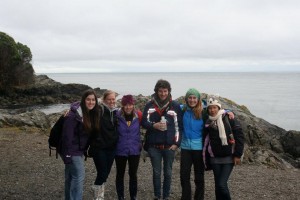
Read More
BLOG:
There is an old sailor tale that tells of a large ship one day caught in the middle of the Ocean. A large wave came over the side and knocked their anchor down into the depths of the ocean. No matter how much the sailors heaved and pulled they could not seem to pull up the anchor, and feared that if they pulled to hard they would make a hole in the bottom of the ocean, and drain out all the water. A brave sailor dove off the bow of the ship with knife in hand, ready to face whatever lay at the bottom of the sea. After a few tense minutes the sailor burst to the surface of the ocean and told the others that he had freed the anchor, and the ship was free to sail. After they had pulled him up onto the deck they asked him how he had freed the anchor. The sailor told them that a giant octopus had grabbed onto their anchor and was playing with it, but he had tied its legs into bowline knots, so it would never bother them again.
Although we didn’t encounter giant octopi on the Gato Verde (http://www.gatoverde.com/), I think this story reviles subtle truths about life out at Sea. First of all as a crew you have to be ready for anything whether it be a sea creature, or just the logistics of where to dock at night. Learning to be ready for anything at anytime takes a while to get use to, but like everything else we learned while on the Gato it seems to apply not only to sailing and science, to life.
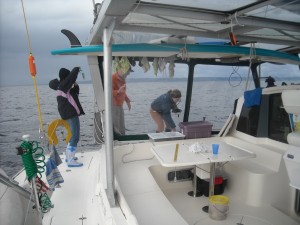
More Sailing!
One of the most important lessons I took away from the Gato was an understanding of what it takes to live sustainably. It is all too common to go through life unaware of the impact you are making, and the resources you are using. I feel that before my time on the Gato I was somewhat aware of my impact, and attempted to live sustainably, but I did not fully recognize the effect of everything I did. On the Gato we took measurements of the fresh water, sewage, and bio- diesel used. These are things that are easy to take for granted in every day life, but when living on a boat you start to realize just how much water you use, and sewage you produce. We had a water tank that held all our fresh water for dishes, drinking, and cooking with. Our water holding tank was on the port side of the Gato over the left hull. The water level was measured in cm and converted to liters and gallons. It was interesting to see how much water we used everyday. We still used a lot of water per person everyday, so it hard to imagine how much water we use daily when taking showers. The sewage tank was on the starboard side of the Gato near the bow. The sewage system was connected to the heads (bathrooms), which were on both the port and starboard side of the boat. Before the Gato I had not idea of how much sewage 8 people can produce, let alone a city, and how difficult sewage can be to deal with. Captain Todd explained the different types of holding tanks a boat can have, and the different ways to treat them. He had a type 3 system, which was an anaerobic system. He introduced a certain species of bacteria into his system that out competed the bacteria that make sewage smell. It was amazing to think that we had a tiny ecosystem on board the Gato with us. Who knew poop could be so fascinating!
In order to conserve bio-diesel we attempted to sail when the wind allowed. Although we didn’t get many opportunities to sail, it was a fun time when we did. Captain Todd taught us about the different points of sail: close-hauled, beam-reach, broad reach, running, and irons (no go zone). We got to steer the boat on our first cruse tacking down the Strait of Georgia. We learned how to sail right against the irons, without going into irons (60-50*) an ideal angle for sailing. We learned about how to let out the jib and main sail, and how to properly put both away.
As a class we also had to figure out our daily navigation. To do this we had to take a lot into consideration: the weather, sea state, tides, where the whales were, and where we would spend the night. At first this seemed to be a logistic nightmare, but after we created a routine for the navigator it became relatively easy. The hard part of navigating occurred when we had to make important decisions during the day, like if we were going to try and catch the whales.
Boat life is difficult, but extremely rewarding at the same time. Looking back my best memories of the boat involve sitting on the trampoline and just appreciating the sea that surrounded us.
Read More
Today is the last day of Beam Reach, and I don’t know how it went by so quickly. I came into this course ten weeks ago unaware of the amazing people I would meet, how much I would learn, and grow (unfortunately not height wise). So much has happened in ten weeks it’s difficult to sit down and distill it into words, but I will try. As class we were an unusual fit, we came in from completely different backgrounds, with different interests, from all over the world, but despite these differences we became inseparable.
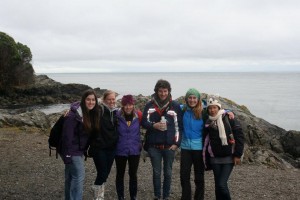 03 Skinny Love
03 Skinny Love
As time went on, and the class presented more challenges we never forgot to save time to laugh, and talk to one another. During stressful nights we would have the occasional dance party to help us get through our work in good spirits, but we also never forgot that we were at the labs to study whales.
The first time we encountered whales Robin, our lead professor, came running through the door of s1 out of breath to tell us their were whales in San Juan Channel. We dropped everything and ran as fast as we could down to the point to watch the whales. For many of us it was our first time seeing Orcas. It is an amazing feeling the first time you see a dark black fin slowly rising up out of the water. Its as if the whole world is centered on the magnificence and beauty of this one amazing animal. As the transients silently swam by it became clear to me at that moment why the work we did in this course mattered.
Since that first encounter with the whales I have never forgotten why I am here. I am sad that the course is coming to an end, but could not have asked for a better group of peers to spend the past 10 weeks with. They have inspired me to laugh, love, and learn everyday, and for that I am grateful.
Read More

on the boat
One of the more challenging aspects of living on a boat is having to cope with resource constrains, communication and mobility limitations. I don’t think I was fully prepared for this before I went on the boat. It only struck me after I had been on the boat for a few days that cell phone connection was intermittent in the Salish Sea, there was limited internet access, and we were not always docked.
This was not an easy lesson to learn and I realized that I had to think really far ahead in terms of planning my work. Although we generally had internet connection at Snug Harbor, the connection can get cut off when the boat moves, or sometimes even fail completely. I really had to budget my time and make full use of “internet timeâ€. Moreover, I could not rely on internet being available for the entire night.
Both Dr. Kodner and Dr. Buckman, our guest for two nights, were really helpful in helping me cope with this challenge. Most of the time, students use database (SQL) queries to filter and arrange data. This requires internet. When internet is not available, there is only Excel, which has a myriad of useful functions that make data analysis that much easier. Furthermore, Dr. Veirs has suggested that it’s possible to work with SQL as an offline application. That’s something!
Read More
I never thought I would be able to call the sea my home, but after living on a boat for an extended period of time, I can truly call myself a sailor, and a sustainable one at that! The Gato Verde is the only biodiesel electric commercial sailboat in the country, which makes it pretty darned special. It’s considered sustainable because of the myriad of things that keep the cat green, like being able to use the slightest touch of wind to power the boat. When the wind is lacking, the boat simply runs on electric power, and when electric power runs low, the boat is backed by biodiesel.
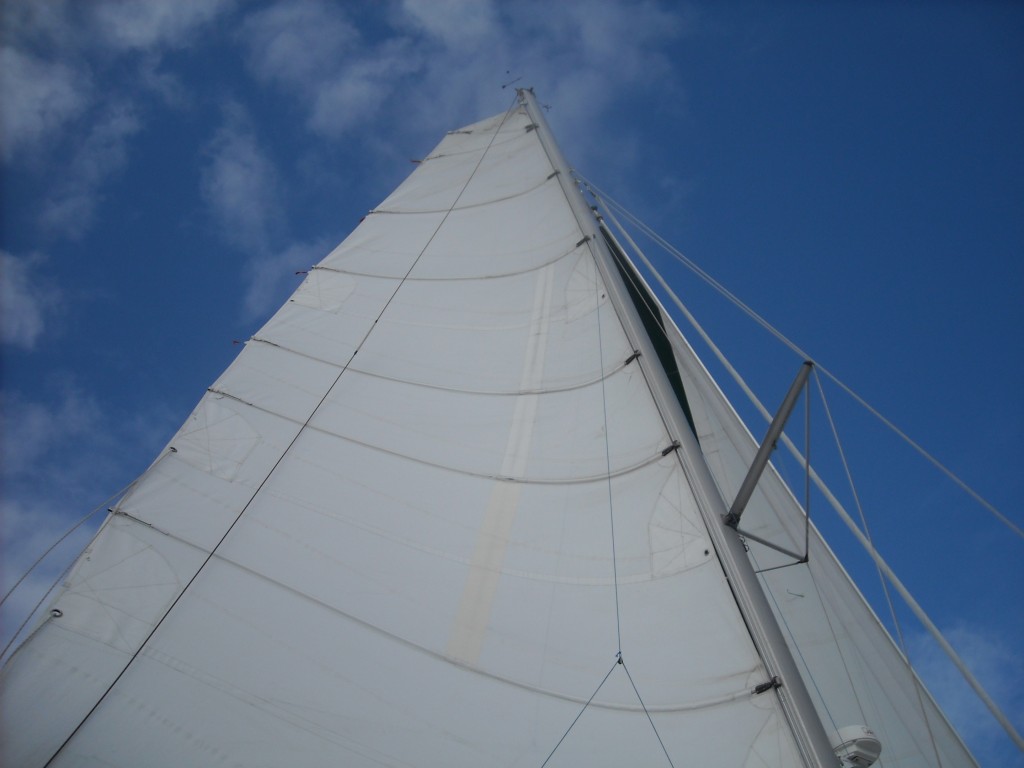
Sailing!
The electric power of the Gato is provided by heavy, lead acid batteries. These batteries are the same batteries that can be found in cars and their weight adds to the drag on the boat. In order to make the Gato more efficient and sustainable in the future, the type of battery used could be switched to lithium polymer batteries, which are lighter, more abuse tolerant, and could power the boat alone for a full four hours, as opposed to the current two hours that the lead acid batteries provide now. In addition to the battery type change, Captain Todd hopes to yet improve the sustainability of the Gato by converting the current black water system to a grey water system.
While we were out sailing through the Salish Sea, we had to constantly be conscious of our black water system. The black water system on the Gato Verde is the where the human waste is held, home to a unique ecosystem of hazardous pathogens, and it was how we kept our waste from entering the marine environment. We had two holding tanks on the boat, a primary and a secondary. When the primary holding tank was filled, it was pumped into the secondary holding tank and when both tanks were full, it was time to make a trip to pump out. We created a decent pump out rule, as pumping out is not always the most pleasant thing to do. The rule was that whoever did not pump out had to buy ice cream for whoever did pump out. Because of this, pumping out ended up being one of our favorite things to do on the boat! In addition to measuring the amount of waste produced, daily calculations were made of fresh water usage, biodiesel fuel, and power consumed.
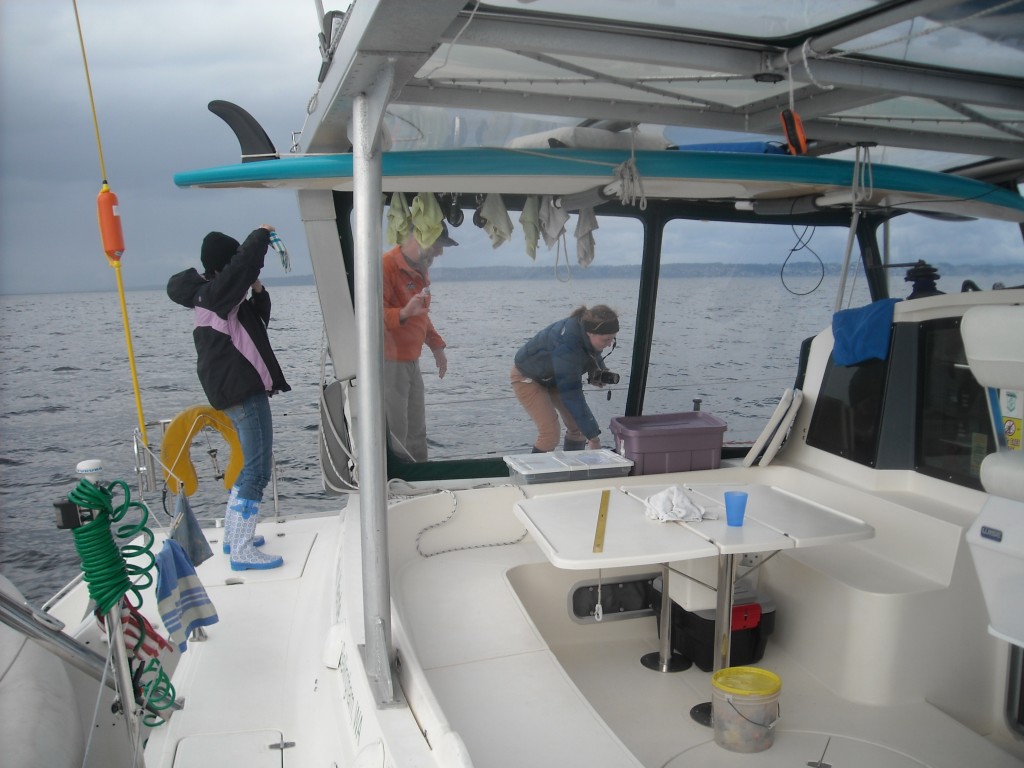
More Sailing!
When the environment permitted, we used it to maximize our efficiency. A few days out on the Gato allowed us to hoist the mainsail and test our skills at sailing. We used the wind to our advantage and optimized our angle with the wind, maneuvering the boat with the jib sheet by tacking. In addition to the different aspects of sailing, we learned a lot of other valuable information, like how to tie a double sheet bend knot, which is used to tie two lines together. My all time favorite knot was the bowline. I got so good at tying a bowline that at one point, I somehow managed to tie one single handed! Another knot I became very quick at tying, which I think is the most aesthetically pleasing knot of all, is the cleat hitch. The cleat hitch was used every time we docked instead of mooring or anchoring.
There were a number of tasks to accomplish when we anchored for the evening. To start, we lowered the anchor into the water. After the anchor was lowered, a bridle was put on the anchor chain to reduce the tension on it. We observed the angle of the anchor chain each time we anchored to be sure the anchor was secured at the sea floor.
One of my favorite things about sailing was the rare opportunity we had to view the southern resident killer whales from the water. As we approached the end of our voyage, we were all wondering when we would be able to see the greatly anticipated whales. Finally, three days before our trip ended they showed up and stayed in the Salish Sea long enough to be with them on each of our last days on the boat. Our last day, the whales were not very vocal, but they put on quite a show for us at East Point. We were running from port to starboard, shouting out behaviors like crazy! It was amazing to see how much of a mood booster the whales could be.
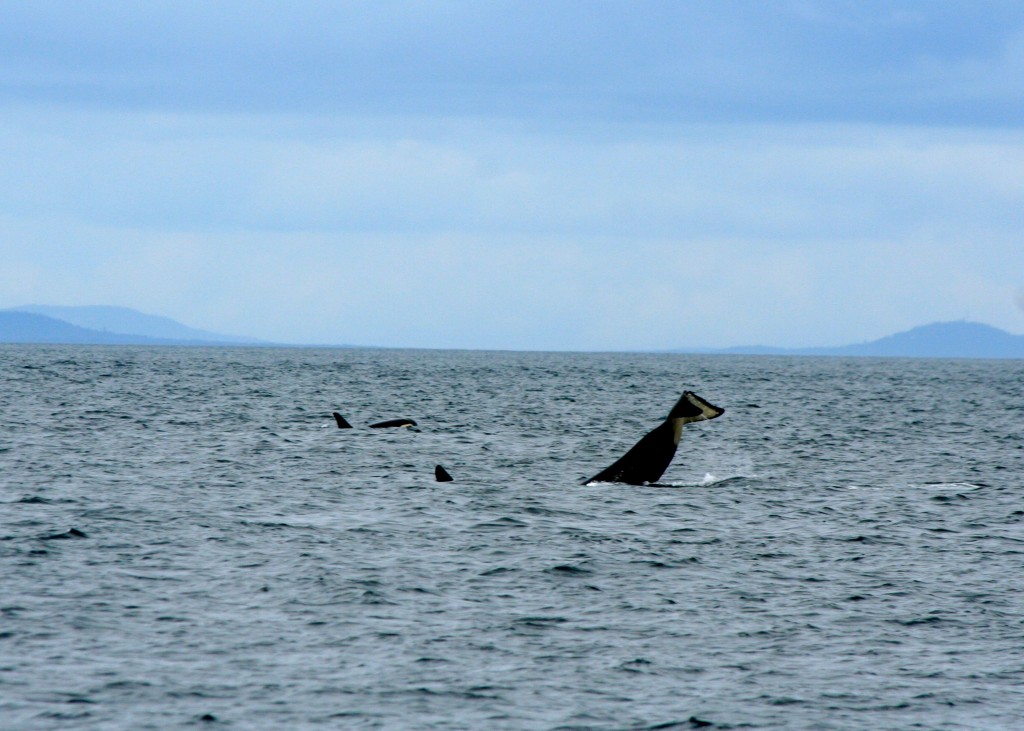
Killer whale tail slap, photo courtesy of myself (my pride and glory)
After a long, arduous, and exhausting week here at the Friday Harbor Labs, we have finally passed the threshold of our looming presentations. I will be sad to say goodbye, and while I know that I will never, ever forget the time I have spent here, it’s always difficult to leave a place where you feel so at home. This truly has been the experience of a lifetime. I have made lifelong friends and learned valuable skills and information that I will be able to use in almost every situation. Congratulations to the Beam Reach 121 class of spring 2012, you’ve done it!
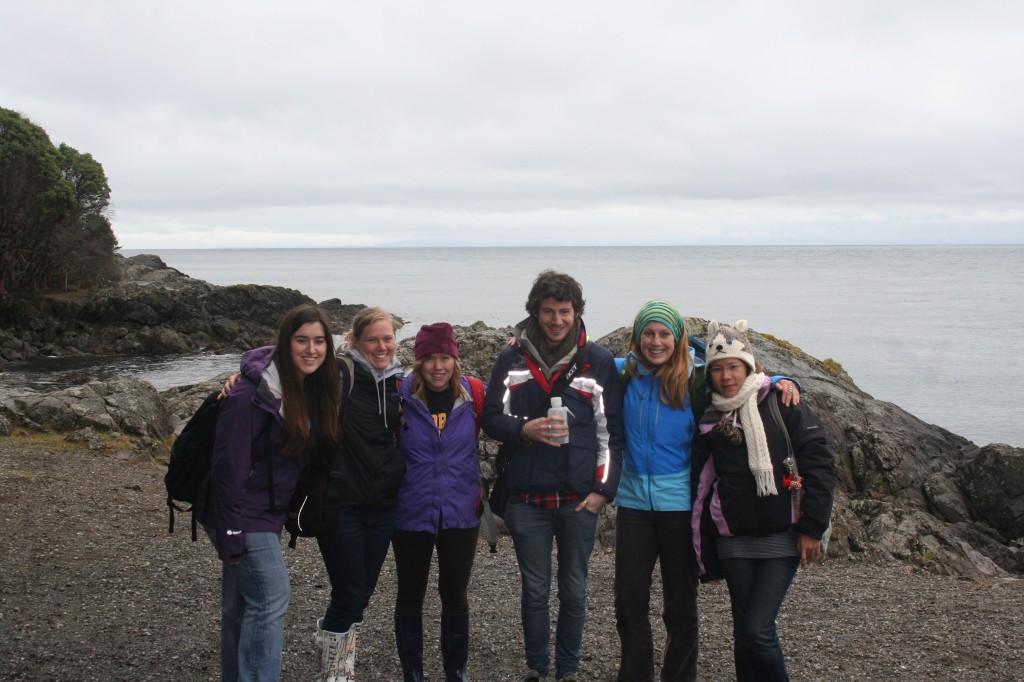
I love these guys!
We take so many things for granted on land. Water appears to pour from an endless well and electricity is immediate at the flick of a switch. On the ocean, however, these luxuries have to be rationed as we can only use what we can store. In addition, any waste products, such as black water, have to be stored, and disposed of responsibly. Whilst out at sea, for example, human waste was carried around with us until it could be ‘pumped out’ at Roche Harbor. The Gato Verde had two holding tanks for the purposes of storing human waste. The three weeks spent on the Gato Verde have certainly helped me to understand and appreciate how much more sustainable we can all live. In the past when I have heard the term sustainability, I have automatically associated this with either a big change in lifestyle or a large investment. The reality, however, is that we can all live healthier and more sustainable lives if we just use things in moderation.  Whilst out on Gato, as part of our morning chore rotations, measurements were taken of water usage, sewage level, and amount of biodiesel used. This allowed us to graph and monitor our footprint over the duration of the trip.
Compared to many vessels, the Gato Verde, a 42 ft electric biodiesel hybrid catamaran , is pretty special in that it was modified to be more environmentally friendly. Such modifications include converting to LED lights, and changing the sail plan to optimize efficiency. This involved adding a screecher to take full advantage of any wind, and by making the main sail a ‘square top’ to increase surface area. There is no cleaner fuel than the wind itself. If there is little wind then the Gato uses quiet electric motors to help it move through the water. Compared to most motors, these have little noise impact on the environment. The Gato also burns biodiesel, a renewable fuel source, that not only powers the vessel through the water, but, also can be utilized to charge the boats batteries.  Despite the Gato’s current success in being sustainable, further modifications are being considered for the foreseeable future. In the short term, Captain Todd hopes to add solar panels and a wind generator to be even more energy independent. Research is also being directed into alternative grey water systems.
Although we were busy collecting physical oceanography measurements such as conductivity, salinity, visibility, and plankton density, there were a number of opportunities for us to learn about the Gato and the process of sailing. In the early stages, there was so much terminology to get our heads around and knots such as bowlines and sheet bends seemed impossible. In the latter part of our trip, however, this new language felt a lot more natural. For example, when asked to pull in the jib, I knew that this was the middle sail (not to be confused with the main sail or screecher). The masts supporting these sails were themselves held in place by a forestay and shrouds. Out of all the sails, we used the jib the most as it is designed to operate in lighter winds. By using the wind to our advantage, less fuel was needed to travel the same distance. In addition to using the wind, tides and currents were also exploited. By using the environment we could ultimately be more sustainable. After long days of science, we would head back to either moor or dock on nearby islands. Out of all the places we visited, my favourite was Patos Island. On occasions, we were forced to anchor. This however was avoided wherever possible because of the damage it inflicts on the marine environment. Towards the end of the two weeks, we could prepare the anchor with as little as two students. We were mostly responsible for directing Captain Todd, operating the windlass, and preparing the bridle. The idea behind the bridle is that once attached,  it helps to distribute the stress on the boat. The final stage of the  anchoring process involved attaching the chain hook.
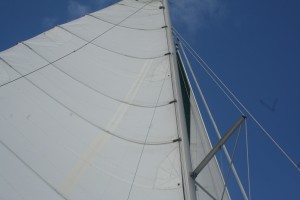
Raise the main sail
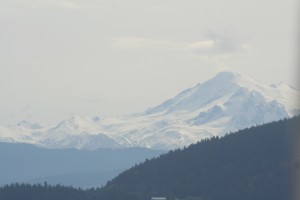
View from my berth
It was a sad moment when the Gato sailed off from the Friday Harbor labs. Although I was happy to be back on land, I am now itching to get back on the water. I feel that living onboard the Gato has prepared me well for the future. In the space of two short weeks we have learnt so much, skills that will last a lifetime.
Read More
We’ve been back on land for two days now and we’re all still adjusting to life on solid ground. I used to think that from my experiences as a kid on a sailboat, that I knew what it was like to live on a boat… that couldn’t have been farther from the truth. After two weeks on the boat we only just began to scratch the surface of what living in the field is like. It was like no experience I’ve ever had, and I will never be the same because of it. In attempt to stop you from thinking that this experience was anything less than incredible I will give you a little behind the scenes glance of what it was like, and how much fun we actually  had. Our days normally started around 8:00 am in the galley for breakfast. After that we took care of our chores for the day which ranged from cleaning the decks and heads to acting as the navigator and mapping a course for the day. We were able to stay at some pretty amazing islands, like Jones pictured below.
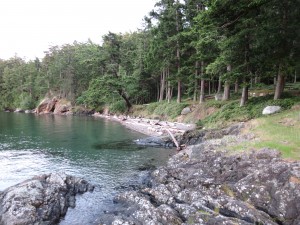
Since our days with whales were limited we collected a lot of physical oceanographic data from the CTD and other equipment like the Secchi disk which measures visibility in the water. We even had the opportunity to sample at one site for the entire day to see how the ocean changed at that one location over time.As the days without whales continued we became more creative with our data collection. It was in these days that we learned how far we were willing to go for our research. Phinn, one of the other students, decided to jump in the water every hour for 7 hours during the day to get horizontal secchi measurements as opposed to the usual vertical readings. After jumping into 8 degC water ourselves earlier that week this seemed absolutely crazy. Even so we jumped in again on a later day and swam around for 25 minutes. With the Olympic mountains in the background it was absolutely breathtaking… oh wait that was the water.
After a week on the boat with no reports of whales we were getting antsy. We delved into collecting as much data as we could and in turn analyzing that data, which I am still doing. We were very successful in collecting a lot of data. Finally we ran into some luck and heard of the whales coming in through the Strait of Juan de Fuca. Even though we woke up at 5:00 am to listen to hydrophones we missed them passing our anchorage and we had to play a bit of catch up. We eventually caught up to the whales and were able to collect both behavioral and acoustic data using the 4 hydrophone array. Suddenly our other needs became secondary and we adjusted course to follow the whales. We ended up having two more days with the whales as they led us from one end of the Salish Sea to the other. Our last day with them was amazing. We were with the whales for about 2 hours and witnessed some amazing behavior like spyhops, tail slaps, and even a few breaches. All of this set against the background of the sun setting on the horizon. While we had some struggles with adjusting to this life style it was an absolutely amazing experience that was hard to walk away from.

What made this experience so special was the boat we were on, The Gato Verde. This is no ordinary boat, it is the first plug in diesel electric hybrid charter boat on the west coast. Stretching to a luxurious 42 ft the Gato was an incredible home away from home. It isn’t special simply because of the amount of space aboard, but because the boat is a pioneer in the field of sustainable boating. Most boats have a motor that runs on gasoline that in turn powers the propellers which move the boat through the water, but the Gato isn’t like any other boat. Captain Todd Shuster added a diesel generator, and a large battery bank in order to make the boat more green. The generator runs on diesel which is cleaner and less explosive than gasoline and the battery banks helps create more clean energy. This would be all fine and dandy by itself, but the Captain took the extra step and taught us about why he made the changes to the boat and how it is creating more sustainable travel and less impact on the environment.
As part of our course we learned about sailing and the different parts of the boat. We even had a knot tying lecture, I can now tie several knots including a reef knot, clove hitch, and cleat hitch. The cruise began with us as students learning about the different aspects of sailing and quickly turned us into actual sailors. We regularly helped raise the jib for sailing and deployed the anchor at nights when we were not on a dock or mooring buoy. We did not get much ideal weather for sailing but when we did we made sure to take advantage of the wind and put our mainsail up. Sailing is another example of how the boat is green. When we had ideal weather conditions we could take advantage of our environment, turn the motor off and use the power of the wind to move the boat. While docked one night we rested next to another sail boat that had a wind generator. This acts like a small turbine that harnesses wind energy and can be used to power the boat. Adding this to the Gato would be yet another way to make the boat more sustainable. One aspect of sustainability still being addressed is the issue of blackwater. Blackwater is waste water loaded with  biological material like feces. Living on a boat we naturally accumulated black water that was stored in holding tanks since we could not just dump the waste into the ocean. It poses a danger to the environment due to the amount of bacteria and contaminants from human waste that are not naturally occurring in the ocean. So we had to pump out our waste at pumping stations like the one in Roche Harbor.
While some aspects of living on a boat were challenging, like timing our location with our need to pump out our holding tanks, and living in such close proximity to people, this was the most amazing experience of my life. I learned so much about the Salish Sea and clean boating as well as about myself and just how far my limits reach. I am sad that our time on the Gato has come to an end, but now I get to analyze the results from all of the data we took and put my piece into the larger puzzle that is the Salish Sea.
Read More
It was like whale soup out there today! After a quiet period over the last week or so it was encouraging yesterday to hear that the whales had once again returned to the area. The killer whales were first heard in the early hours from the Lime Kiln hydrophones (http://orcasound.net/), however, as the morning progressed the whales were reported further north. We had our suspicions that they would be heading towards the Fraser river via Active Pass in search of Chinook salmon. Chinook salmon are thought to be the Southern resident’s preferred prey because of their large size and high lipid content. The navigation team responded to the various reports by planning a route to intercept the whales in the Strait of Georgia. Although we were a few hours behind the whales, the Gato finally caught up with the whales by the coal docks at Tsawwassen. The twelve or so whales at the docks were later identified as members of J pod. Although the seas were quite rough, we still managed to record over two hours of behavioural data. Unfortunately the whales weren’t vocal, and so little acoustic data was taken. After a great afternoon with the whales we headed to Patos Island for the night. It was the first time that this particular Beam Reach class had moored at Patos. Patos is one of the most northern islands in the San Juans, and is strategically located close to both the Strait of Georgia and Boundary Pass.
It was another early(ish) start this morning with the hope of catching up to the whales. Fortunately, the currents and tides were working in our favour. We met the whales between Salmon Bank and Hein Bank (a few miles south west of San Juan Island). There seemed to be a number of groups spread out across the Strait. Whereas the whale watch companies stuck with the ‘main group’ we decided to follow a smaller focal group of a few individuals. This decision paid off because we were able to record some great vocalisations. Over the hydrophone array we heard many S1 calls and clicks. The S1 call is the predominant call type for J pod and suggested to be a contact call. Contact calls are primarily used to establish the location of other pod members during certain behavioural states (Ford and Fisher 1983). Many of our research projects are focusing on S1 calls, and therefore the crew were delighted to hear them over the hydrophones. Not only were the whales vocal, they were seen spy hopping and tail slapping around the boat. Today was the first time that I had seen an Orca spy hop. I was completely lost for words. We stayed with this particular group for over two hours before riding the flood north back to Snug Harbor. Whales were also encountered as we neared Snug Harbor; these whales were also quite active, and were observed lunging out of the water. Over the last few days, we have recorded some incredible acoustic and behavioural data that we are still in the midst of processing and analyzing. Everyone is pleased that we have finally seen some whales. Hopefully this ‘whale run’ will continue over the next few days. I will keep you posted.
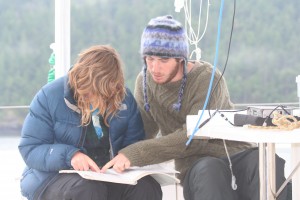
Navigation decisions
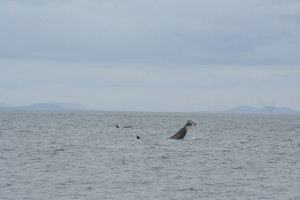
Tail Slap!
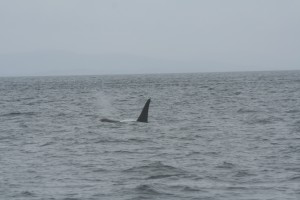
Large Male
All week long, papers have been flooding the tables and fingers have been punching away at keyboards in our humble abode, S1. Everything was put on hold this weekend for our overwhelming proposals that each of us just barley managed to finish in the nick of time last night at midnight. Hooray! They’re finally finished! It was stressful, but it was also really fulfilling to be able to write a somewhat formal, scientifically written document. And that was just the beginning of the weeks of research to come, as we embark on our next epic, week long journey, collecting data on the Gato Verde. Beam Reach wasn’t the only class working on research proposals this week. Many of the other classes here at the labs were developing ideas for their research, and it was really fun to hear about all of the cool science that is yet to come. From something as tiny as phytoplankton to a creature as massive as a whale, the sea never ceases to amaze me with all that it has to offer.
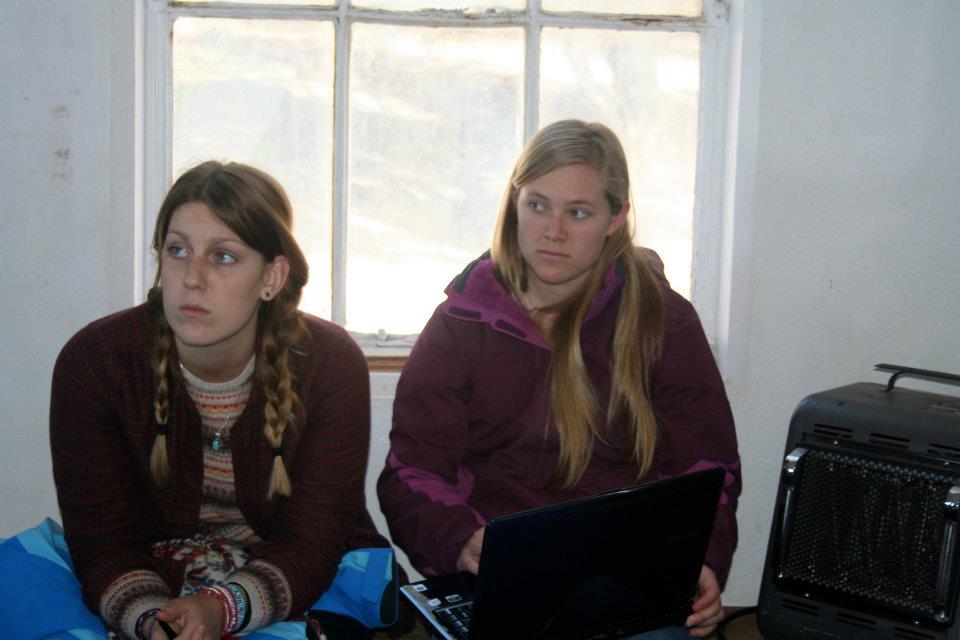
Learning in the Lighthouse at Lime Kiln
The majority of our class time during the past week was spent at Lime Kiln, observing and collecting data for our upcoming research, and we had the best observations anyone could ask for! Resident killer whales swam to and fro in front of the lighthouse, making a dramatic appearance as if showing off to the six of us Beam Reach students, seeing them for the first time there. There was so much technical work to cover while we were at the lighthouse in preparation for our upcoming boat excursion, but according to Murphy, it wasn’t really that important. Generally, I would be unhappy about Murphy’s law interfering with our critical working and learning environment, but not this time. In my book, seeing the whales was not only one of the most important parts of my week, but also one of the most special.
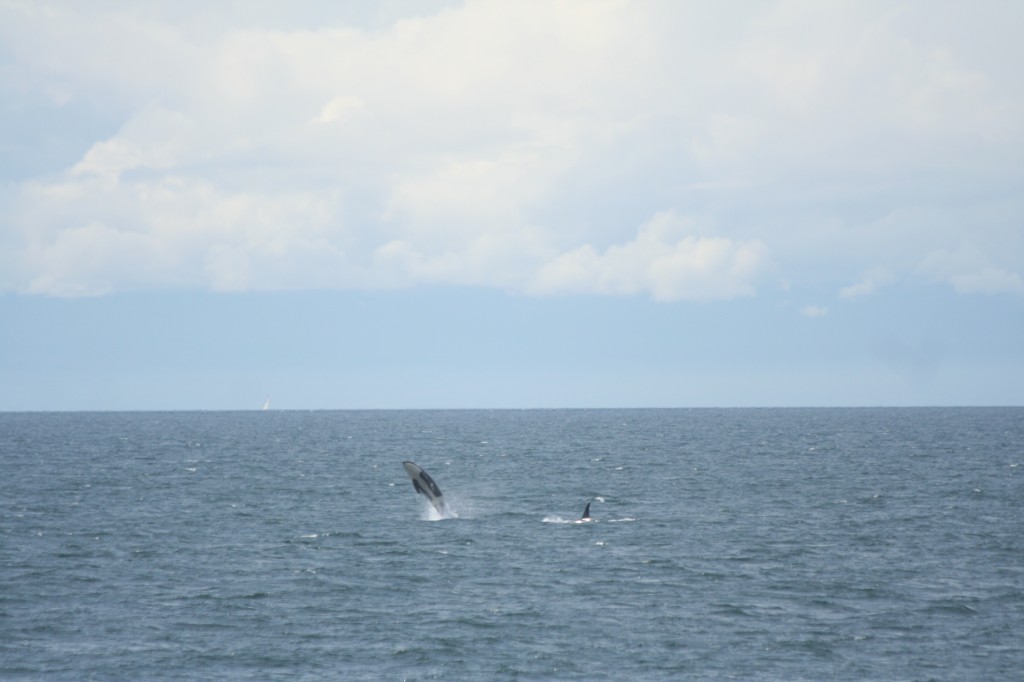
Breaching Killer Whale!
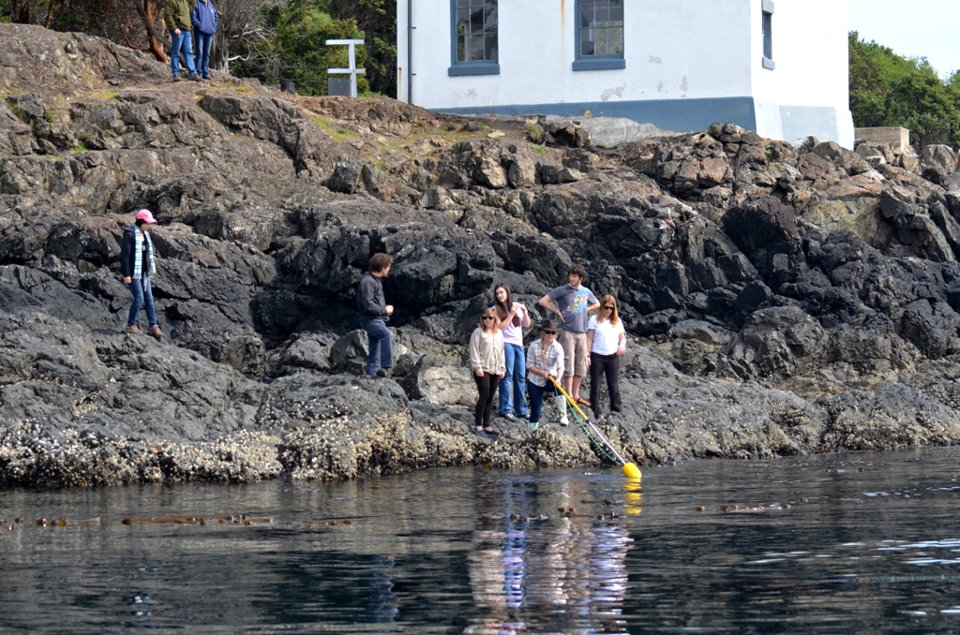
- Plankton tow at Lime Kiln
In our proposals, we adapted our ambitious hypotheses to accommodate the allotted time and instruments that are available to us for our research. After a lot of hard work and consideration, my hypothesis turned out something like this: in areas of the water with limited visibility, the rate of the S1 call increases in comparison to all other calls. I am pretty excited because I am developing my own visibility profiles of the aquatic environment in which the resident killer whales live, so it feels like I am doing some pretty legitimate science. The profiles I am creating are in relation to the abundance of particles, phytoplankton, and light in the water. My theory is that with more things in the water, it becomes harder for the whales to see, which in turn would have them be more reliant upon their vocal communication skills.
It has been an intense week in Beam Reach, and I imagine the intensity will be even more apparent when the writing of our full blown papers commences, but I am still so psyched to be living the life of a marine biologist and I wouldn’t have it any other way. I cannot believe how time has flown over the weeks that I have spent here in Friday Harbor. It seems like just yesterday that I was stepping off the ferry onto this beautiful and mysterious soil for the first time, relishing the unique ocean habitat that the resident killer whales are fortunate enough to experience throughout the duration of their lives. I am sure that the memories I have made here, and the memories yet to come in this short span of ten weeks, will last a lifetime.
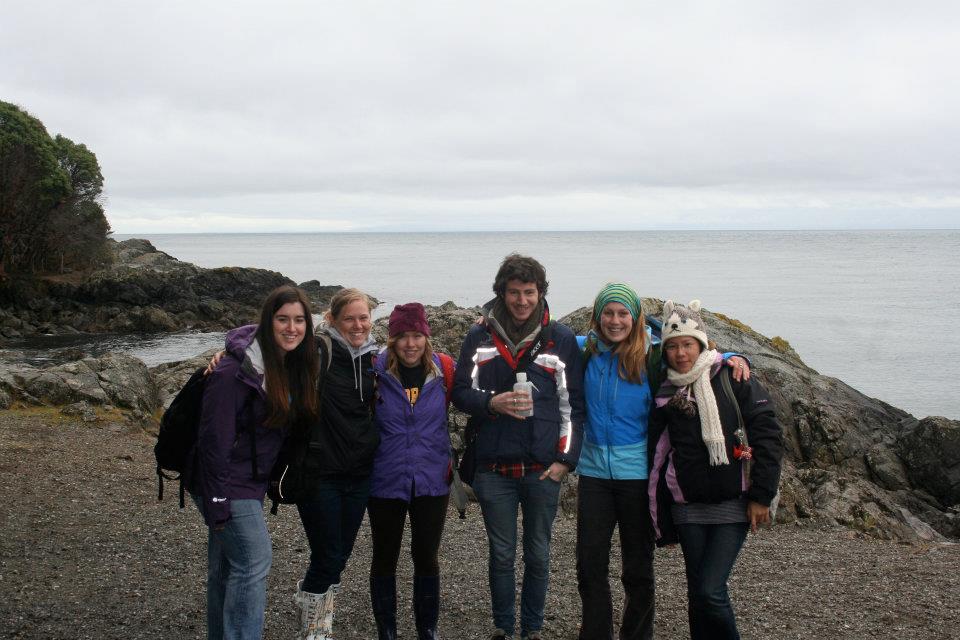
Dana, Me, Jamey, Phinn, Bre, and Taya at Lime Kiln























 Twitter
Twitter LinkedIn
LinkedIn Facebook
Facebook